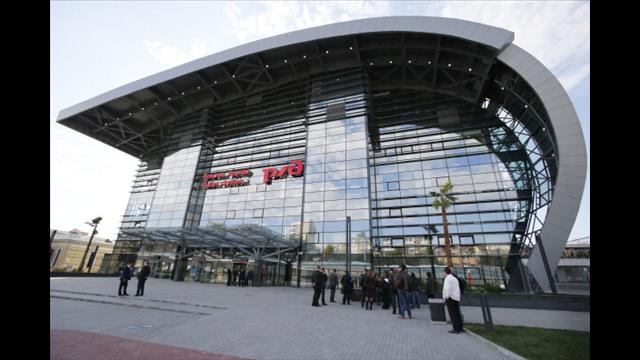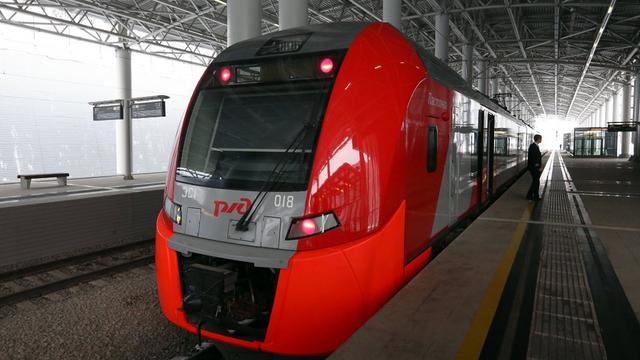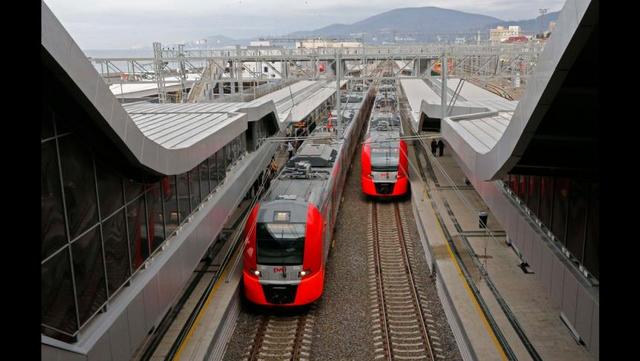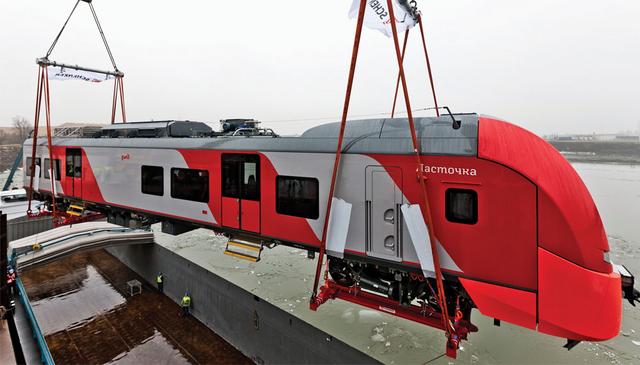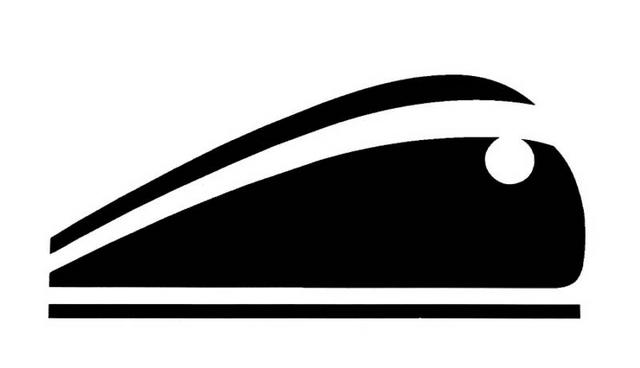New trains
Russian Railways is building the key transport route of the Sochi games — a combined automobile and railway line between Adler and the Alpica-Service mountain health resort.
From the resort, it will be possible to get to the Sanki Sliding Center and other Olympic facilities. The line stretches for 30 miles, passing through 12 tunnels and over 46 bridges. The combined length of roads built for the project exceeds 80 miles.
Another new railway line will connects central Sochi and the local airport. More than 50 percent of all air passengers arriving for the Games will use railway transport to get to the city.
Estimated travel time will be under one hour. This is the fifth such air-rail service to be launched in Russia after Moscow, Yekaterinburg, Vladivostok and Kazan.
The line will be served by Lastochka trains. This new type of electric locomotive, based on the Siemens Desiro design, has been developed for commuter transportation in the Russian environment.
It can operate in outside air temperatures between -40 and 104 degrees Fahrenheit, under humid and icing conditions.
Furthermore, the Sochi Lastochkas will be the first trains in Russia to have wheelchair lifts fitted. In fact, all Russian Railways facilities in Sochi have been built or retrofitted to accommodate disabled passengers.
Measures include special aural visual annunciation and Braille signage on signposts and timetables, as well as dedicated ticket counters, wheelchair ramps, lounge areas and lavatories for the disabled.
Moscow is looking to build four new railway stations in the next few years, Izvestia reports. They will focus on servicing high-speed trains, which will be running on three routes — to St. Petersburg, Adler (near Sochi) and Yekaterinburg (1,155 miles from Moscow) — at a speed of up to nearly 250 miles per hour.
The trains are expected to travel twice as fast as the Sapsan trains, which operate at a speed of 100-155 miles per hour. It will now take only between 2 and 2.5 hours to get to St. Petersburg from Moscow.
The Moscow Committee for Architecture has already submitted proposals to the Directorate of the Moscow Transport Hub for two high-speed train station sites: one in Perovo, to the east of the capital; the other in Tsaritsyno, in the south of the city.
Valentin Murashov, head of the traffic planning department at Institute for Transport Economics and Development (a subsidiary of the Russian Railways company), warns that not everyone would be happy about the stations being so far from the city center.
“It is not really logical that a person arriving in Moscow on business should find themselves slap bang in the middle of a residential area. There are a few options that are closer to the city center — they could build a new terminal near Kalanchevskaya Station and perform a large-scale reconstruction of Kursky Railway Station,” he says.
Kursky Station, which lies within the Garden Ring Road, could be replaced with a multi-level building similar to Berlin Central Station: One level would service shuttle trains, the second would work with long-distance trains, and a third would be designated for high-speed trains.
Russian transport More about transport
The two remaining new stations will be built for New Moscow residents. In 2011, the government extended the capital to the southwest: an ambitious move that will more than double the total area of the city.
Murashov believes that the New Moscow stations will work with long-distance trains. “Currently, there are no stations there for long-distance trains. There is a proposal to build a new line to link the Kiev and Kursk routes — New Moscow lies between them — and a station to service such trains on this new line. Another option is to build two stations, one on each route,” he says.
By train
The 105-kilometre (65 mi) length of Greater Sochi makes the railroad one of the fastest and most suitable transports to travel between the city districts. For a long period Sochi had the only line going from Tuapse to Abkhazia and beading five major stations, four minor ones, and 28 platforms inside the metropolitan area. Preparing to 2014 Olympics, RZD constructs two new lines (from Adler to the airport and from Imeretinskaya lowland to Krasnaya Polyana) with total lenght of 48 km (30 mi) and five new stations and platforms.
Commuter trains of Sochi have been constantly improving during recent years, upgrading from standard Russian elektrichki to modern and comfortable ones. Most of them go from Adler (or from Sochi central terminal) to Tuapse and back. There are also 1-2 trains daily to Krasnodar and Maykop. One way ride from Sochi to Lazarevskoe will cost 45 RUR for an ordinary elektrichka (1 hour 45 minutes). A modernized commuter train ticket is more expensive: from 100 to 200 RUR depending on class, but also faster (50-70 minutes). Expect to pay 40 percent more if going to Lazarevskoe from Adler (2 hours 20 minutes for an ordinary elektrichka).
While summer hot season brings more interregional trains to Sochi, the number of local commuter trains is decreasing for that period. So, there are only six round-the-year local trains (16 in off-season period). The good news is that each long distance train will also stop at Adler, Khosta, Sochi, Loo and Lazarevskaya stations, so it is possible to travel inside the city by these trains. The bad news is that you will need a passport each time you are buying a long-distance train ticket.
A brand railroad has just been opened in Sochi.
The length is nearly 50 kilometers/30 miles and now it takes guests not more than 30 minutes to get from Sochi to Winter Games sport facilities as trains can speed up to 160 km per hour/100 mph. The route crosses 50 bridges, a lot of embankments, and goes through 12 tunnels (the exact length of all the tunnels is 30,5 kilometers/19 miles).
Adler station opens ready for Sochi 2014
BY NEWSIN RAIL NEWS — 1 NOV, 2013
A new seven-storey railway station that will be used by spectators and athletes attending the Sochi Winter Olympics has been officially opened by Vladimir Putin.
The new station in Sochi’s southern district of Adler covers an area of 30,000 square metres and will welcome around 15,000 passengers every hour when the Winter Olympics starts in 98 days time.
Speaking at the opening ceremony, Russian Railways’ president Vladimir Yakunin said: “The Adler node integrates all areas of Olympic routes, from the ice palaces of the Olympic Park to the snowy Krasnaya Polyana stadiums, the international airport, and downtown Sochi. Long-distance passenger trains will come here.”
Work began on the transport hub, which even includes a winter garden on its upper level, in 2010.
The new interchange, which was designed and built by Mostovik, will connect the Olympic village in Adler with the Alpica-Service resort, which will host a number of events.
Aug 2012 ⋅ by David Shirres ⋅ in Featured rail engineer Rail News, Rail Projects ⋅
Clinging to a narrow strip of coastline between the Caucasus Mountains and the Black Sea, the 150 kilometre long Sochi conurbation (A conurbation is a region comprising a number of cities, large towns, and other urban areas) is the world’s second-longest after Los Angeles. Its terrain is such that planes can only land at its airport from the sea. In Russia, Sochi is a popular tourist resort with long beaches, tropical palms, sunshine and a humid subtropical climate. In 2007, it was chosen to host the 2014 Winter Olympic and Paralympic Games.
Although this might seem an odd choice, Sochi does have a mountain winter resort 48 kilometres inland where the outdoor events will be held. Indoor games are to be held on the coast at a new Olympic Park which, after the games, will be the site of the first Russian Grand Prix. Given that most of the £21 billion being spent preparing for these games is on infrastructure improvements, the rail engineer was keen to accept an invitation from Russian Railways (RZD) to see its Olympic rail improvements.
Into the mountains
As the mountain venue is currently reached by a twisting narrow road through a deep river valley, a new high capacity road / rail corridor is required. This project includes a 50km road with six major junctions and a 48km railway with two new stations. This line will be electrified at 25kV and climbs to 560 metres with a maximum gradient of 1 in 25. It is single tracked in the mountains with four dynamic loops, giving a capacity of four train pairs per hour. Due to the demanding nature of the terrain, 46% of this new line consists of bridges or tunnels. This explains why the project’s cost is £4.5 billion, of which 60% is the new rail line.
With such a narrow corridor, road and rail construction is inseparable. For example, there are three tunnel complexes where parallel road and rail tunnels share the same service tunnel. As shown in the table, 12 tunnels totalling 27.4km are being constructed by Tunnel Boring Machines (TBM), Roadheaders (RH) or Drilling and Blasting (DB). TBMs are both German Herrenknecht and Canadian Lovat machines. Rail, road and service tunnels are typically 10.6, 13.2 and 6.2 metres in diameter. All rail tunnels are single tracked, except for the double tracked Number 6 tunnel, and the scheme won New Civil Engineer’s Major Tunnelling Project of the year in 2011.
Bridges galore
The project includes 23 rail and 23 road bridges, totalling 11.5 km and 9 km respectively, criss-crossing the river Mzymta. Bridge designers had to take account of the region being subject to earthquakes and a curvature radius of 600 to 1200 metres for most of the rail bridges.
The large number of bridges, required by the design to minimise the impact on the river bed, meant that they could be built in kit form with standard components. Beam spans ranged from 18 to 34 metres and trussed girders from 55 to 110 metres. The exception is a 766 metre cable-stayed road bridge, with pylons 82 metres high and a maximum span of 312 metres. At this location, the river runs directly below the line of the road and the long bridge removes the need for pylons in the river.
The project’s enabling works are a further indication of its scale. These include eight work camps housing 7,800 people, five access roads totalling 37km and 10 temporary bridges. Electrical substations at the tunnel portals have a total capacity of 41.3 MW and are fed from 40km of new power lines. On the coast, two freight yards were opened in 2009, one for aggregates and one for construction components, with annual capacities of 11 million and 3.7 million tons respectively. The largest construction facility is a tunnel lining plant that also houses 570 workers. The production capacity of its four production lines, which produce various types of lining, is 15,000 cubic metres per month.
A controversial aspect of the project is its environmental impact on the Sochi National park, in particular the river Mzymta. In consultation with Greenpeace Russia and the Worldwide Fund for Nature (WWF), the design was changed to either avoid particularly sensitive areas or to minimise impact by the use of elevated structures. Other mitigation measures include planting 163,000 rare plants, the provision of animal crossings and releasing 50,000 salmon yearlings into the river. Once construction is complete the riverbed and floodplain will be subject to remedial works.
Russian Railways Go for the Gold
Articles Below on Infrastructure Improvements for the Games
